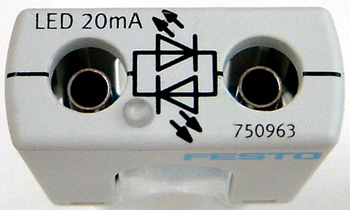LED, red or green

A light-emitting diode (LED) is a semiconductor component that emits light and has the electrical characteristics of a diode. If an electric current is flowing through the diode in forward direction, it emits light with a wavelength that depends on the semiconductor material and doping.
In this component, a green and a red LED with opposite polarity are connected in parallel. Depending on the current direction either the green or red LED lights up. Connected to alternating current with a frequency higher than about 30 Hz, the human eye cannot recognize the blinking and it seems as if both LEDs are lit simultaneously.
Since version 5.6c the maximum power P_max can be specified. If this value is exceeded during simulation, the diode burns out. For reasons of compatibility with older circuit diagrams, the default value is unrealistically high.
Adjustable parameters
| Designation | Range | Default value |
|---|---|---|
| Maximum power | 0.1 ... 100000 W | 1000 |
| Resistance in series | 0.001 ... 1000 Ohm | 9 |
| Designation | Range | Default value |
|---|---|---|
| Reference voltage | 0.1 ... 100 V | 2 |
| Reference current | 1 ... 10000 mA | 25 |
| Saturation current | 1e-15 ... 100 A | 1e-12 |
| Designation | Range | Default value |
|---|---|---|
| Reference voltage | 0.1 ... 100 V | 2.2 |
| Reference current | 1 ... 10000 mA | 30 |
| Saturation current | 1e-15 ... 100 A | 1e-12 |